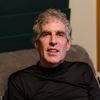
Hubbard Street's Winter Series was a memorable showcase; the five or six thousand people who saw the company's four performances in Chicago this December, like those who will see them in January and February on an extensive tour of the U.S. West Coast, had a chance to enjoy everything that makes a dance concert successful. Winter Series was a display of intricately woven choreography, a textured and complex fabric made out of an uncountable series of beautifully focused performance moments. Most of all, though, the choreography of Winter Series achieved something remarkable, and probably unintended. The program showcased an invisible and misunderstood force in the visual world of choreography; Hubbard Street's Winter Series was a master class in how to use music in dance.
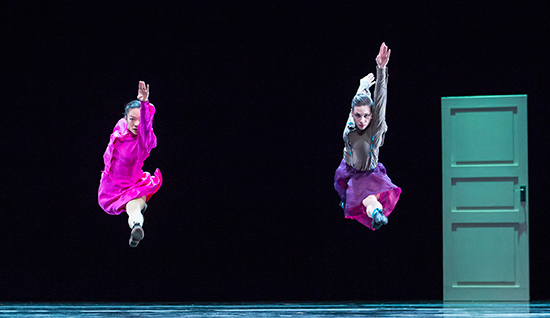
Hubbard Street Dancers Jessica Tong and Jacqueline Burnett in "Casi-Casa" by Mats Ek
Photo by Todd Rosenberg
The first work of the evening, Aszure Barton's "Untouched," would be beautiful as a still photo, and her movement design, staged dramatically on a lush and captivating set, would probably be enchanting even in silence. It might get old quickly, though, as movement without music so often does. Although dancers and choreographers often love the drama of moving in silence, or the perceived impact of movement set to unorganized sound, it doesn't seem likely that a substantial audience ever will. Barton must have a thorough understanding of why that's so, because "Untouched" carries an apparently effortless momentum from beginning to end; it's a beautiful example of how movement and music together can transport an audience.
Whatever the secret of Barton's flawless sense of trajectory, some of that magic is in the music. The score is a collage of selections from Curtis Macdonald, Njo Kong Kie and Lev "Ljova" Zhurbin, and although the notes to the work say that the choreography was developed "prior to selecting the music," there is probably much more to such a creative story. Barton is so subtle, and so powerful in using the structural development of the music to animate her architecture that it would be amazing if the full design of the work really preceded the score.
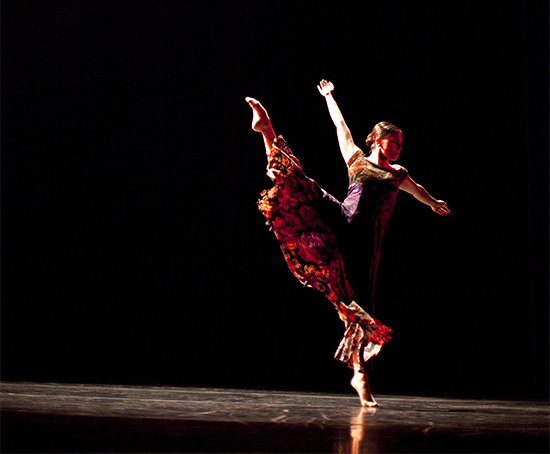
Hubbard Street Dancer Jacqueline Burnett in Aszure Barton's "Untouched"
Photo by Todd Rosenberg
"Blanco" by Alejandro Cerrudo is every bit as successful; Cerrudo can choose music like a composer, and "Blanco" is simple but brilliant in the design of it's score. Two works for piano, one a dark and mysterious prelude by Charles-Valentin Alkan, the other a prelude and fugue by Felix Mendelssohn, illuminate Cerrudo's truly unique vision. The short-form quartet is performed almost entirely side by side, facing the audience from a very small area at the front of the stage, mostly in a series of interchanging solos. The set is as mysterious as Alkan's prelude, the movement design as refined and energetic as Mendelssohn's fugue and the piece is mesmerizing in its coherence with the music.
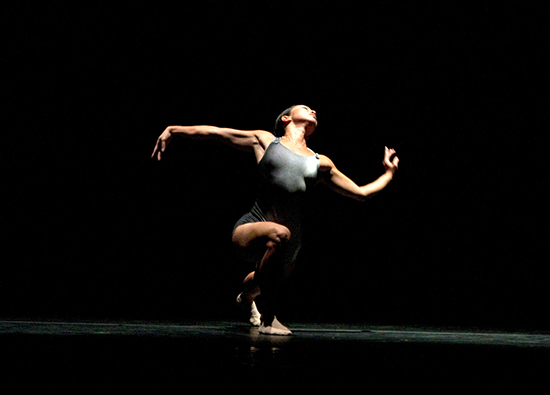
Hubbard Street Dancer Jessica Tong in "Blanco" by Alejandro Cerrudo
Photo by Kristi Pitsch
If anyone went to Winter Series looking for a chance to learn how music and dance can move together, Barton and Cerrudo were worth the ticket price and a bunch of college credits at least, but Mats Ek's "Casi-Casa," set to an original score by Fleshquartet, was like a 40-minute graduate degree. The Swedish group's music is made by five people, a string quartet and a percussionist, and they do so much so well that you could mistake the score for orchestral, or full-production electronic. The choreography moves with each of the music's multichromatic moods with such natural ease that it's as if the movement is at the same time independent of the riveting sound design and made out of it; there's no telling where the movement was made for the music and where the music was inspired by the movement.
In each of these works, music is used to such careful effect that an audience, guided measure by measure through complex choreographic visions, might be enchanted without ever knowing it. It's an invisible art, the way that great choreography can find and embody the primal motions of musical change. The more successful the process is, the less it can be identified, because an audience will see only the dance concert as more potent because of the mysterious interplay of such powerful motive forces.
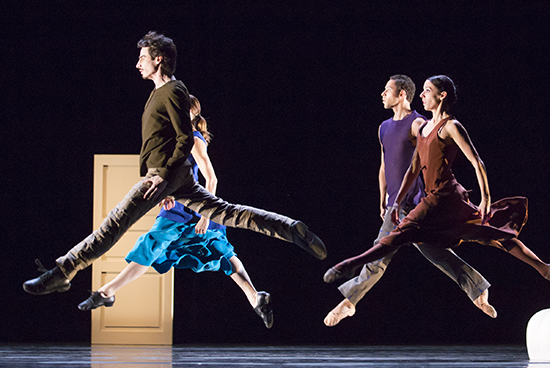
Hubbard Street Dancers Alejandro Cerrudo, Meredith Dincolo,
Jonathan Fredrickson and Ana Lopez in "Casi-Casa" by Mats Ek
Photo by Todd Rosenberg
There are, after all, only two physical senses, seeing and hearing, with which a choreographer, a stage full of performers and a dance company can share anything with an audience. It's not easy to bring the multitude of choices in movement, costume, lighting and set into harmony with equally complex choices in melody, texture and tone, but when it's done really well, it's a very different kind of art. It's still called choreography, but it becomes a voyage so engaging that an audience no longer knows which is wind and which is water. They only know that they saw a truly brilliant dance concert.
This story originally appeared at aotpr.com.
